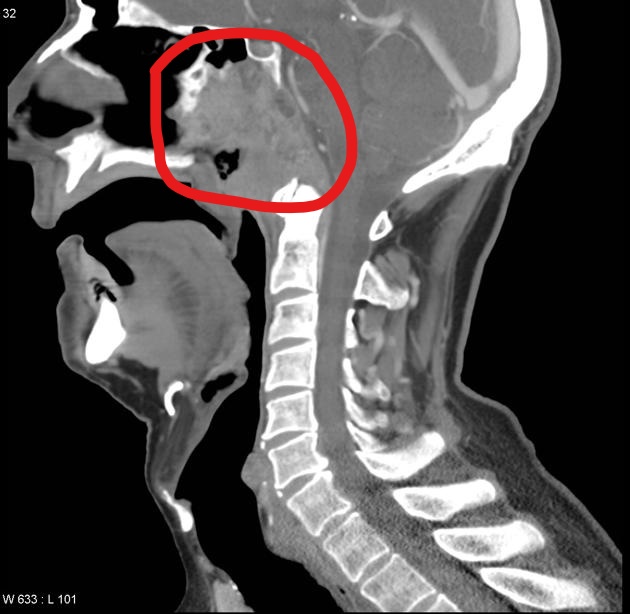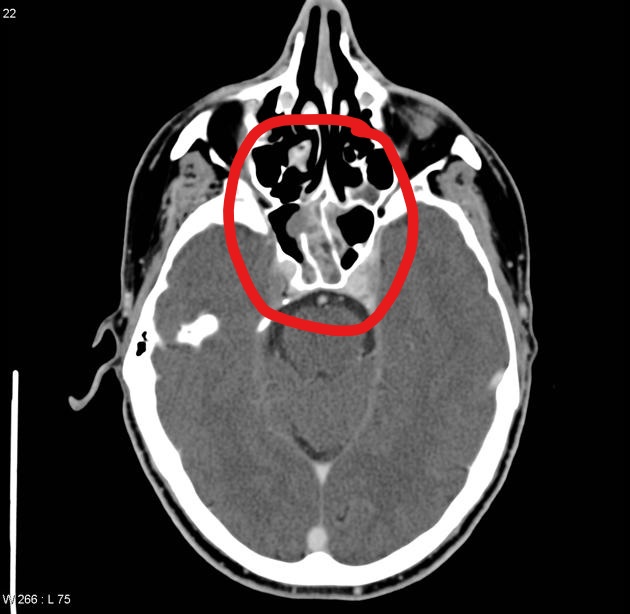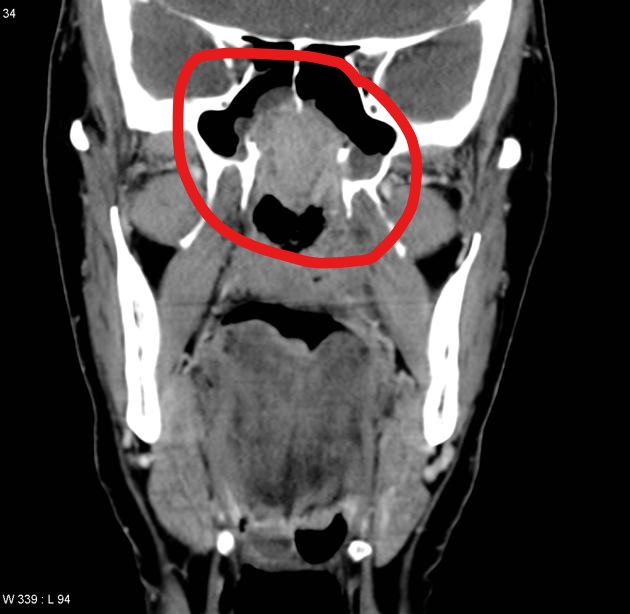Nasopharyngeal carcinoma CT: Difference between revisions
m (Bot: Removing from Primary care) |
|||
| (13 intermediate revisions by 3 users not shown) | |||
| Line 1: | Line 1: | ||
__NOTOC__ | __NOTOC__ | ||
{{Nasopharyngeal carcinoma}} | {{Nasopharyngeal carcinoma}} | ||
{{CMG}} {{AE}}{{Faizan}} | {{CMG}}{{AE}}{{Homa}}{{Faizan}} | ||
==Overview== | ==Overview== | ||
CT scan may be helpful in the [[diagnosis]] of nasopharyngeal carcinoma and it's [[metastasis]] to the [[lymph node]]<nowiki/>s, [[intracranial space]], [[bone]], [[chest]], and [[liver]]. Findings on [[CT scan]] suggestive of nasopharyngeal carcinoma include [[soft tissue]] [[mass]]<nowiki/>es which most commonly centred at the [[lateral]] [[nasopharyngeal]] recess ([[fossa of Rosenmüller]]) and [[heterogeneous]] enhancement ofthe [[tumor]] in the [[Computed tomography|CT scan]] with [[contrast]]. | |||
==CT scan== | ==CT scan== | ||
[[CT scan]] may be helpful in the [[diagnosis]] of nasopharyngeal carcinoma and it's [[invasion]]. [[CT scan]] can be useful in:<ref>{{Cite journal | |||
| author = [[V. F. Chong]], [[Y. F. Fan]] & [[J. B. Khoo]] | |||
*[[Eustachian tube]] | | title = Nasopharyngeal carcinoma with intracranial spread: CT and MR characteristics | ||
| journal = [[Journal of computer assisted tomography]] | |||
*Base of skull | | volume = 20 | ||
| issue = 4 | |||
*[[Foramen | | pages = 563–569 | ||
| year = 1996 | |||
| month = July-August | |||
| pmid = 8708057 | |||
}}</ref><ref>{{Cite journal | |||
| author = [[Alfred L. Weber]], [[Sharif al-Arayedh]] & [[Asma Rashid]] | |||
| title = Nasopharynx: clinical, pathologic, and radiologic assessment | |||
| journal = [[Neuroimaging clinics of North America]] | |||
| volume = 13 | |||
| issue = 3 | |||
| pages = 465–483 | |||
| year = 2003 | |||
| month = August | |||
| pmid = 14631685 | |||
}}</ref><ref>{{Cite journal | |||
| author = [[Julian Goh]] & [[Keith Lim]] | |||
| title = Imaging of nasopharyngeal carcinoma | |||
| journal = [[Annals of the Academy of Medicine, Singapore]] | |||
| volume = 38 | |||
| issue = 9 | |||
| pages = 809–816 | |||
| year = 2009 | |||
| month = September | |||
| pmid = 19816641 | |||
}}</ref><ref name="CurranHackney1986">{{cite journal|last1=Curran|first1=Walter J.|last2=Hackney|first2=David B.|last3=Blitzer|first3=Peter H.|last4=Bilaniuk|first4=Larissa|title=The value of magnetic resonance imaging in treatment planning of nasopharyngeal carcinoma|journal=International Journal of Radiation Oncology*Biology*Physics|volume=12|issue=12|year=1986|pages=2189–2196|issn=03603016|doi=10.1016/0360-3016(86)90019-2}}</ref><ref name="ChongFan1997">{{cite journal|last1=Chong|first1=V F|last2=Fan|first2=Y F|title=Detection of recurrent nasopharyngeal carcinoma: MR imaging versus CT.|journal=Radiology|volume=202|issue=2|year=1997|pages=463–470|issn=0033-8419|doi=10.1148/radiology.202.2.9015075}}</ref><ref>{{cite book | last = Hermans | first = Robert | title = Head and Neck Cancer Imaging | publisher = Springer Berlin Heidelberg | location = Berlin, Heidelberg | year = 2006 | isbn = 3540684395 }}</ref><ref>{{cite book | last = Som | first = Peter | title = Head and neck imaging | publisher = Mosby | location = St. Louis | year = 2011 | isbn = 9780323053556 }}</ref> | |||
*[[Diagnosis]] of nasopharyngeal carcinoma in [[Computed tomography|CT scan]] (with and without [[Contrast|contras]]<nowiki/>t), the characteristics are: | |||
**<nowiki/>[[Soft tissue]] [[mass]]<nowiki/>es which most commonly centred at the lateral [[nasopharyngeal]] recess (fossa of Rosenmüller) | |||
**Heterogenous enh<nowiki/>ancement of the [[tumor]] in the [[Computed tomography|CT scan]] with [[contrast]] | |||
*Detection of [[cervical lymph nodes]] involvement | |||
*Detection of intracranial involvement | |||
*Diagnosis of [[bone metastasis]], by detection of [[lytic]] or [[Sclerotic metastasis|sclerotic]] lesions,the most common [[metastatic]] regions are: | |||
**[[Eustachian tube]] | |||
**Base of [[skull]] | |||
**[[Foramen lacerum]] | |||
**[[Foramen ovale]] | |||
**[[Cavernous sinus]] | |||
**[[Temporal bone]] | |||
*Detection of the [[metastasis]] to [[chest]] and [[liver]] | |||
[[File:Nasopharyngeal carcinoma CT.jpg|500px|none|thumb|https://radiopaedia.org/cases/nasopharyngeal-carcinoma-non-keratising?lang=us]] | |||
[[File:Nasopharyngeal carcinoma CT 2.jpg|500px|none|thumb|https://radiopaedia.org/cases/nasopharyngeal-carcinoma-non-keratising?lang=us]] | |||
[[File:Nasopharyngeal carcinoma CT 3.jpg|500px|none|thumb|https://radiopaedia.org/cases/nasopharyngeal-carcinoma-non-keratising?lang=us]] | |||
==References== | ==References== | ||
| Line 27: | Line 61: | ||
{{WikiDoc Help Menu}} | {{WikiDoc Help Menu}} | ||
{{WikiDoc Sources}} | {{WikiDoc Sources}} | ||
[[Category: | |||
[[Category: | [[Category:Up-To-Date]] | ||
[[Category:Medicine]] | |||
[[Category:Oncology]] | |||
[[Category:Otolaryngology]] | |||
[[Category:Radiology]] | |||
Latest revision as of 22:53, 29 July 2020
|
Nasopharyngeal carcinoma Microchapters |
|
Differentiating Nasopharyngeal carcinoma from other Diseases |
|---|
|
Diagnosis |
|
Treatment |
|
Case Studies |
|
Nasopharyngeal carcinoma CT On the Web |
|
American Roentgen Ray Society Images of Nasopharyngeal carcinoma CT |
|
Risk calculators and risk factors for Nasopharyngeal carcinoma CT |
Editor-In-Chief: C. Michael Gibson, M.S., M.D. [1]Associate Editor(s)-in-Chief: Homa Najafi, M.D.[2]Faizan Sheraz, M.D. [3]
Overview
CT scan may be helpful in the diagnosis of nasopharyngeal carcinoma and it's metastasis to the lymph nodes, intracranial space, bone, chest, and liver. Findings on CT scan suggestive of nasopharyngeal carcinoma include soft tissue masses which most commonly centred at the lateral nasopharyngeal recess (fossa of Rosenmüller) and heterogeneous enhancement ofthe tumor in the CT scan with contrast.
CT scan
CT scan may be helpful in the diagnosis of nasopharyngeal carcinoma and it's invasion. CT scan can be useful in:[1][2][3][4][5][6][7]
- Diagnosis of nasopharyngeal carcinoma in CT scan (with and without contrast), the characteristics are:
- Soft tissue masses which most commonly centred at the lateral nasopharyngeal recess (fossa of Rosenmüller)
- Heterogenous enhancement of the tumor in the CT scan with contrast
- Detection of cervical lymph nodes involvement
- Detection of intracranial involvement
- Diagnosis of bone metastasis, by detection of lytic or sclerotic lesions,the most common metastatic regions are:
- Detection of the metastasis to chest and liver



References
- ↑ V. F. Chong, Y. F. Fan & J. B. Khoo (1996). "Nasopharyngeal carcinoma with intracranial spread: CT and MR characteristics". Journal of computer assisted tomography. 20 (4): 563–569. PMID 8708057. Unknown parameter
|month=ignored (help) - ↑ Alfred L. Weber, Sharif al-Arayedh & Asma Rashid (2003). "Nasopharynx: clinical, pathologic, and radiologic assessment". Neuroimaging clinics of North America. 13 (3): 465–483. PMID 14631685. Unknown parameter
|month=ignored (help) - ↑ Julian Goh & Keith Lim (2009). "Imaging of nasopharyngeal carcinoma". Annals of the Academy of Medicine, Singapore. 38 (9): 809–816. PMID 19816641. Unknown parameter
|month=ignored (help) - ↑ Curran, Walter J.; Hackney, David B.; Blitzer, Peter H.; Bilaniuk, Larissa (1986). "The value of magnetic resonance imaging in treatment planning of nasopharyngeal carcinoma". International Journal of Radiation Oncology*Biology*Physics. 12 (12): 2189–2196. doi:10.1016/0360-3016(86)90019-2. ISSN 0360-3016.
- ↑ Chong, V F; Fan, Y F (1997). "Detection of recurrent nasopharyngeal carcinoma: MR imaging versus CT". Radiology. 202 (2): 463–470. doi:10.1148/radiology.202.2.9015075. ISSN 0033-8419.
- ↑ Hermans, Robert (2006). Head and Neck Cancer Imaging. Berlin, Heidelberg: Springer Berlin Heidelberg. ISBN 3540684395.
- ↑ Som, Peter (2011). Head and neck imaging. St. Louis: Mosby. ISBN 9780323053556.